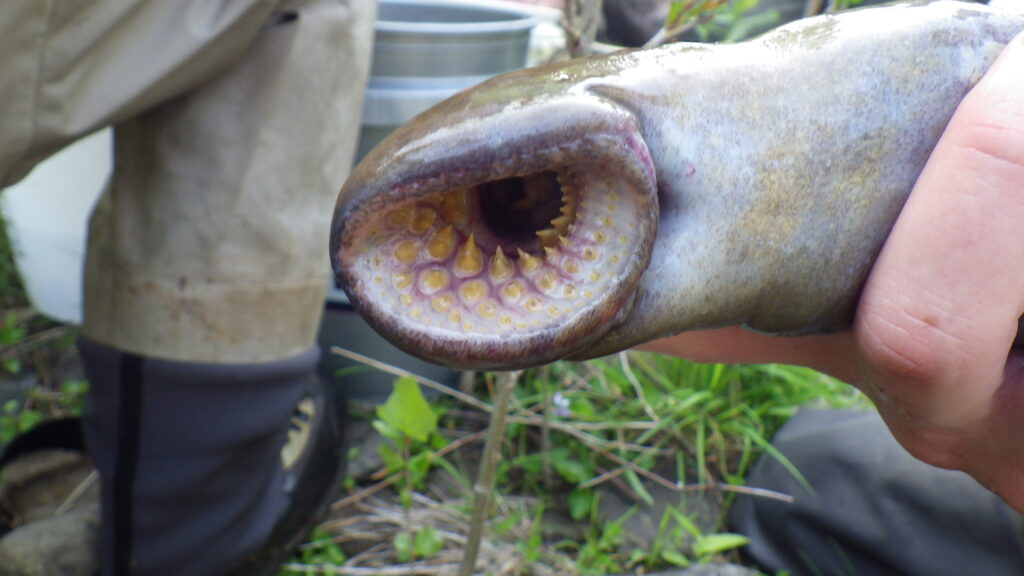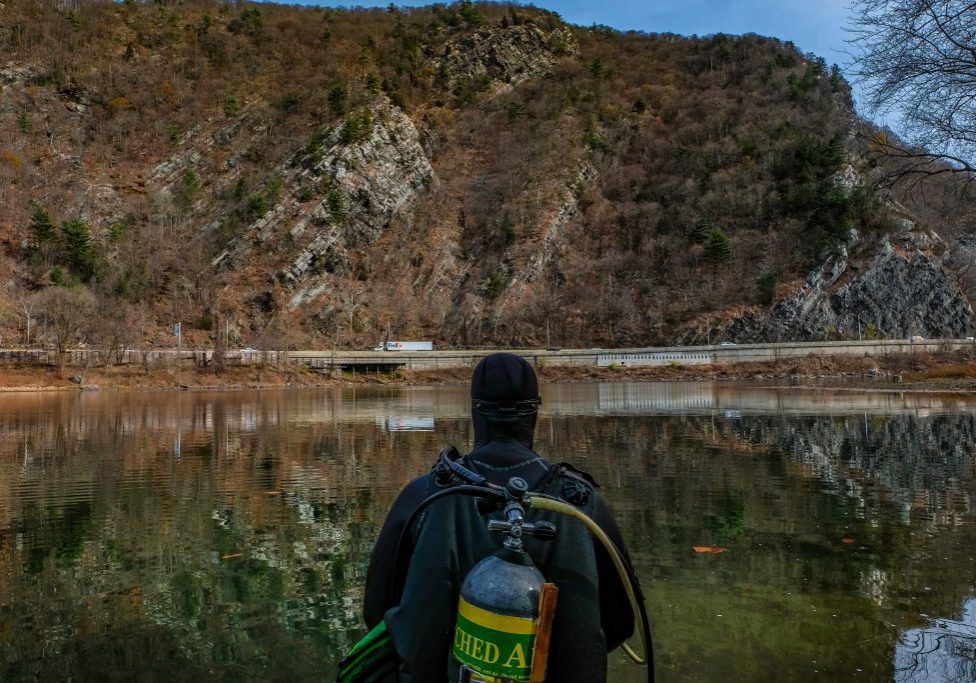
Lampreys: ugly? Maybe, but they play a big role in river health.
Anglers take note
| May 12, 2021
You might look at a lamprey and go “EWWWW.”
But, if you’re interested in the health of the Delaware River, you should say “Yay!”
Which is what Jessica Newbern, a biologist with the Upper Delaware Scenic and Recreational River, would say, as would her colleague, Andy Weber, an ecologist with that national park.


The two posted some photos of lampreys in the Delaware River on the Upper Delaware Scenic and Recreational River’s Facebook page. (You should like it!)

And my, the fur (well, the lamprey IS a fish, so no fur) did fly! Mostly from the haters! If you go the Facebook page, you can see the back and forth.
But let’s get our facts straight. Most importantly, all the experts agree, the lamprey isn’t interested in attaching to us humans, so don’t be afraid of the water!
Also, the lamprey is a fish, and so is an eel but they are only distantly related to each other. So references to “lamprey eels” are mixing up two different things. The proper name for this critter is a sea lamprey, which reflects the large part of its life cycle spent in the ocean.
They get some of their bad reputation not so much from what they eat (fish) but how they eat: They attach themselves to fish and suck blood and muscle. The non-fans have christened them “Vampires of the Deep.” As you can see from the photos, they don’t have jaws, but their circular mouths are ringed with teeth.
Bloodsuckers, sort of like mosquitos. Only mosquitos target us humans, and the lampreys do not.
‘They have a face only a mother could love’
One up for the lampreys. Let’s dig a little deeper to find out why there are enthusiastic fans of the lamprey (for example, Newbern thinks they’re “cute!”) and to understand where some of their bad press comes from (the Great Lakes) and why.
Likely you’ll only see lampreys in the Delaware when they’re racing upriver to spawn. The males build nestlike depressions in the gravel bed of a stream. The female lays lots of eggs that lodge in the rocks around the nest and soon the eggs hatch into larva called ammocoetes — blind wormlike larvae that float downriver and burrow into the silt.
They stay in that silt, benefitting the river by filter-feeding (much like mussels and oysters) for about three to four years. (There’s benefit #2.)
Then they start to change, assuming adult form for the downriver trip to the ocean. Their mouths become suckers and they get that rather nasty looking circle of teeth.
And this part is a little gross, I’ll grant you. Once it gets to the ocean it uses that sucking to attach to bony fish, and use their teeth and a specialized tongue to rasp into the flesh where they suck on blood and muscle.
It’s a pretty strong suction, “like putting your hand over a Shop Vac,” says Marc Gaden, communications director and legislative liaison for the Great Lakes Fishery Commission.
He’s in position to know about the “bad side” of lampreys since they are indeed a real problem in the Great Lakes but even he wants to set the record straight.
“Yes, they have a face only a mother could love,” he said, “But it’s good to encourage them in their native ranges. It was non-native lampreys that invaded the Great Lakes who are virulent like killer bees. They took over the system.”
So, let’s back up a bit to the behaviors of “our” lampreys in the Delaware River watershed. Newbern said if lampreys are able to follow their instincts they spend most of their lives in the ocean and only come upstream to spawn. That journey is the last big expenditure of energy. They spawn and die.
There’s a bonus from those deaths. It helps those little “baby” lampreys, the ammocoetes, who get all their nutrients from fresh water. They are quite small. But then as returning adults coming up from the ocean, they are larger and bring a large influx of marine-derived energy.
When they die the whole ecosystem benefits, ensuring that the ammocoetes as well as other very small insects and other river critters thrive, explained Timothy Wildman, a fisheries biologist with the Connecticut Department of Energy and Environment.(Benefit #3)
And the little critters aren’t the only beneficiaries of the lampreys’ upstream spawning. They are what Alison A. Bowden, an aquatic ecologist for The Nature Conservancy in Massachusetts, called “ecosystem engineers.”
When the adults actively build nests, they move rocks with their suction mouths to create depressions. Breaking up the river bottom makes the river bottom healthier and in the process of nest building, they increase the diversity of insects that live in silt. (Benefit #4)
And for our anglers out there, Benefit #5 is all of that and how they build their nests and spawn in spring.
Wildman again: When adult sea lampreys spawn in the spring, it’s the same habitat that trout and salmon use for spawning — the tail edge of pools. The lampreys pile rocks downstream.
Their digging creates an ideal spawning environment for trout. “We hope to find sea lamprey nests to make spawning easier for brown trout in the fall,” he said.
We might not like the way they look or the way they feed, but Bowden points out that they are a very old species. The earliest fossils of lampreys is from some 225 millions year ago — today’s sea lamprey is very similar.
“When nature comes up with something that works, it doesn’t change,” said Bowden.
The lamprey have gathered at a spawning site in the Mill River, Taunton, Mass. You can see how they’re using their mouths to attach to rocks to move them around — especially at the 1:34 mark of the video. FROM THE NATURE CONSERVANCY MILL RIVER RESTORATION PROJECT.
Following their noses
Their usual life history involves parasitism when they get into the ocean. Ocean fish can usually handle it since they are larger and the lampreys mostly don’t attach for very long. The lampreys and those ocean fish have evolved together as part of the same finely balanced ecosystem.
“They don’t often kill the fish, which really is a better idea for both fish,” said Bowden, though we don’t really know much about their life in the ocean — much like another “beauty” of the Delaware — the horseshoe crab, known for its annual migration to the shores of Delaware Bay to spawn. Afterwards the crabs return to the ocean.
Those horseshoe crabs can be relied on to return to the Delaware Bay year after year.
Not so these lampreys. Some will, of course return, but they don’t return like so many fish do, to their native waters. The lampreys in the North Atlantic, and in the northeast, turn toward land as their instinct tells them to.
Instinct and those ammocoetes, which excrete a pheromone that will travel down to the ocean and “signal” to the returning lampreys that there’s a good spot for spawning somewhere up river.
Basically the lampreys make a sharp right turn to follow that scent.
“Their brain is mostly nose,” says Gaden. By the time they reach their destination they’re nearly dead. Their digestive system has shut down and they’re blind. The males telegraph via pheromones to females when they’ve found a good nesting site and the females will pick up that scent from miles away and head for it straight as an arrow.
But this “follow your nose” way of breeding mixes the lamprey population so that all the lamprey that come into rivers in the northeast are essentially of the same model — they are one spawning population. When they turn toward land, they pick up and follow the first scent they find.
When lamprey populations decline, without ammocoetes, there’s a chance that they won’t get that scent and won’t breed where they have been native. Sometimes a dam has been built and that blocks their path. There’s a significant commitment from states and environmental organizations to restore native lamprey populations where they have faltered, recognizing their value to the river’s ecosystem.
“In the realm of fish restoration,” Wildman explains, “lampreys are an easy one.”
Mostly it involves finding ways to repopulate with native lamprey that have been blocked by dams. That’s the work that Wildman and his fellow fish biologist Kevin Job have been doing, re-populating the Shetucket River, a tributary of the Thames River, which empties into Long Island Sound at New London, Conn.

And so, now that I’ve created more fans for this curious critter, what’s the problem in the Great Lakes?
Well, in a nutshell, man, and our desire to use nature for our own designs without understanding the law of unintended consequences.
Back before the railroads, water transportation was the easiest route to transport goods and people. So a myriad of canals were created to facilitate that. The most likely route for lampreys is the Welland Canal, which was built in 1919 to take boats (and lampreys) around Niagara Falls, connecting Lake Ontario (the lake that connects to the ocean via the St. Lawrence River) to Lake Erie.
But other possibilities include the Erie Canal which connects to the Great Lakes via the Finger Lakes. Or another involves a watershed breach between the watersheds of the upper Susquehanna River and those same Finger Lakes, which could explain the lamprey seen in Lake Ontario in the 1830s. By 1939 they were in all the lakes.
A fascinating discussion of those possibilities is here: https://afspubs.onlinelibrary.wiley.com/doi/abs/10.1080/00028487.2013.879818
Lampreys in the Great Lakes
Gaden said there are native lampreys in the Great Lakes. What is clear is that the now land-locked ocean lampreys wreaked havoc in the Great Lakes wherever they went — which was everywhere.
According to the records of the Great Lakes Fishery Commission, only one in seven fish survived an attachment by a lamprey. It was a tremendous hit to the then-thriving commercial fisheries on the lakes, and the commission itself was largely created to fight the incursion. The fish in the Great Lakes are generally smaller than those in the ocean, and bear in mind that these fish and lampreys didn’t evolve together.
In the 1950s, the commission started its work to fight the lampreys, but as Gaden points out, “From a 40,000-foot view, we have few tools once an invasive species makes its inroads. Because they breed, the problem only gets worse.”
The commission is still fighting.
Since the ’50s there have been very specific chemicals that target the lampreys, called lampricides, that affect only lampreys and dissipate within a few hours. It’s applied to stream beds where there are larvae. By reapplying it once every four years you essentially stop the “scent radar” that attracts lampreys to spawn there.
But Gaden is interested in other control techniques that could marry up, interestingly, with restoration projects. Using that irresistible scent from larvae to attract the lampreys and then capturing the fish and using those fish to restore other areas — connected to the ocean — to restore a diminished population elsewhere.
Some of the biggest obstacles lampreys face are those dams, and there’s work to study if creating a sort of pegboard fish ladder where the dams aren’t too high or too steep to allow the lampreys to wriggle up, attaching to the board with those suction mouths to climb up — much as lampreys do when they encounter a not-very-steep waterfall.
By various means, sea-lamprey control is a success in the Great Lakes. Here’s Gaden:
Sea lamprey control in the Great Lakes (and Lake Champlain and the Finger Lakes for that matter) has been a tremendous success. In the Great Lakes, sea lamprey populations have been reduced by around 90 to 95 percent overall. In Lakes Michigan and Huron, the populations are at historic low levels (post invasion of course). In Lake Ontario, populations have been low and essentially at target for decades. Sea lamprey populations are low but above target in Lake Superior and are above target but trending in the right direction in Lake Erie.
Why are some lakes above target, I’m sure you just asked? Sometimes, like with any population of fish, the numbers just fluctuate naturally. In other instances, like with Lake Erie, a new population emerges; in that case, we think sea lampreys are coming from outside of Lake Erie (I.e., the St Clair River and Lake St. Clair). We have not found the smoking gun indicating where the sea lamprey are coming from, but we’ll find it. With Lake Superior, the sea lamprey numbers might be high because of the abundance of natural prey in the lake like lake trout. Perhaps the sea lamprey just have a lot to eat there.
But, overall, we have achieved a 90-95 percent reduction from pre-control levels. Before control, we lost about 110 million pounds of fish to sea lamprey each year.Today, the loss is around 10 million pounds. Still a lot of fish lost but an order of magnitude less than before control.
Overall, the control program has been everything our founders in 1954 could have hoped for and it serves as the foundation for the $7 billion fishery we enjoy today. The management agencies would not even think of stocking fish for rehabilitation purposes or to support the sport fishery without sea lamprey control. The fish would just be wasted on sea lamprey otherwise. Likewise, natural fish not supported by stocking, such as whitefish and yellow perch, would not stand a chance.
The lesson of the invasive sea lamprey is why there is such emphasis on keeping, for example, another invasive, the Asian Carp out of the Chicago Sanitary and Ship Canal, which empties into Lake Michigan.
And what you define as invasive depends largely on the specific place. Gaden pointed out that while the Great Lakes are trying to support the lake trout population, in Yellowstone, they are an invasive species.
“It’s a funny old world,” says Gaden. “They (sea lampreys) will never settle in and become a valued part of the ecosystem of the Great Lakes. But in the rest of North America or the world, the restoration of the lampreys is very important.
“They really are grotesque looking,” he said, “But it’s bad for an ecosystem to make a judgment based on what something looks like. The fact that they look like an alien is neither here nor there.”
So, now do you agree with Jessica Newbern? Do you think lampreys are cute?








King Henry I enjoyed and ate a lot of lampreys. Was the recipe lost? Anybody still eat them?
I believe that those nasty things are protected in Britain. But I saw a visit to a baker who still made eel pies on an old episode of The Great British Baking Show.